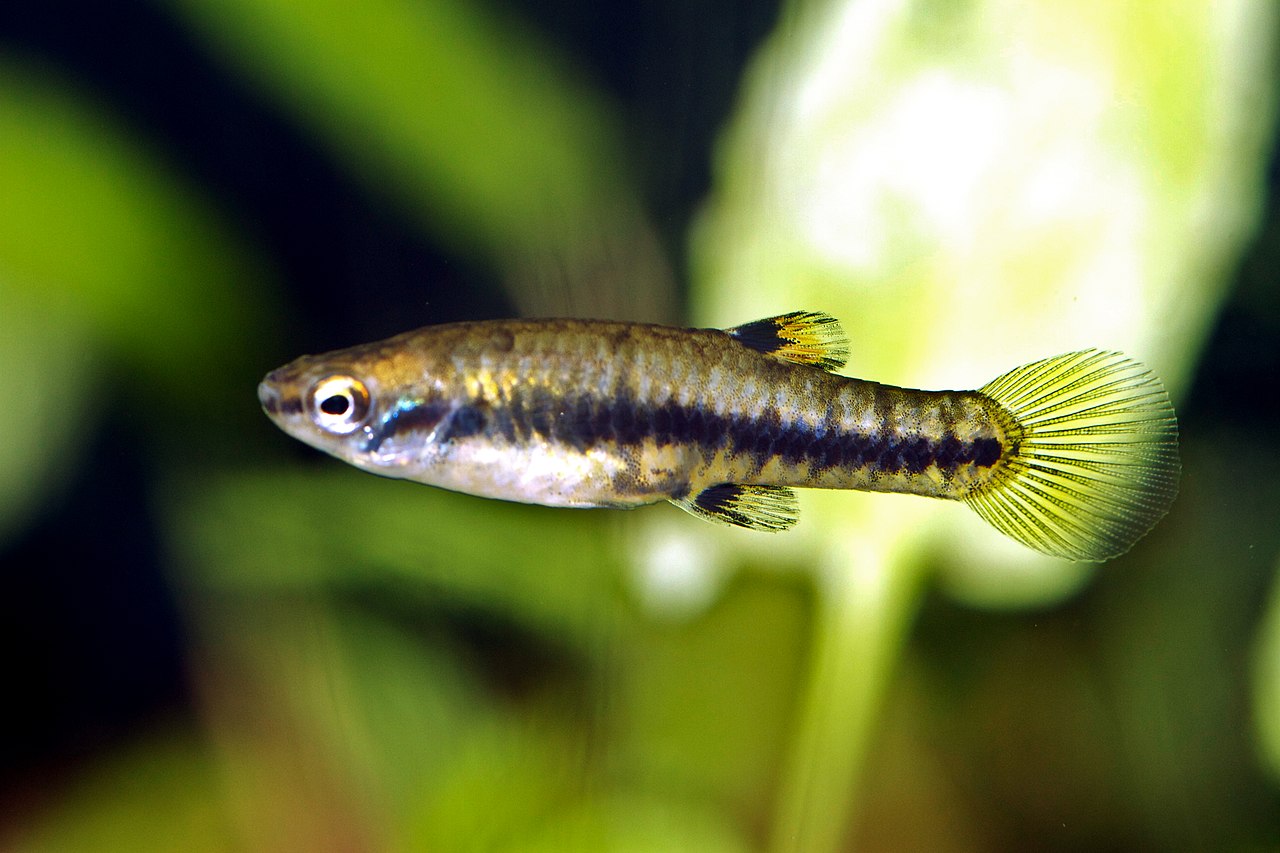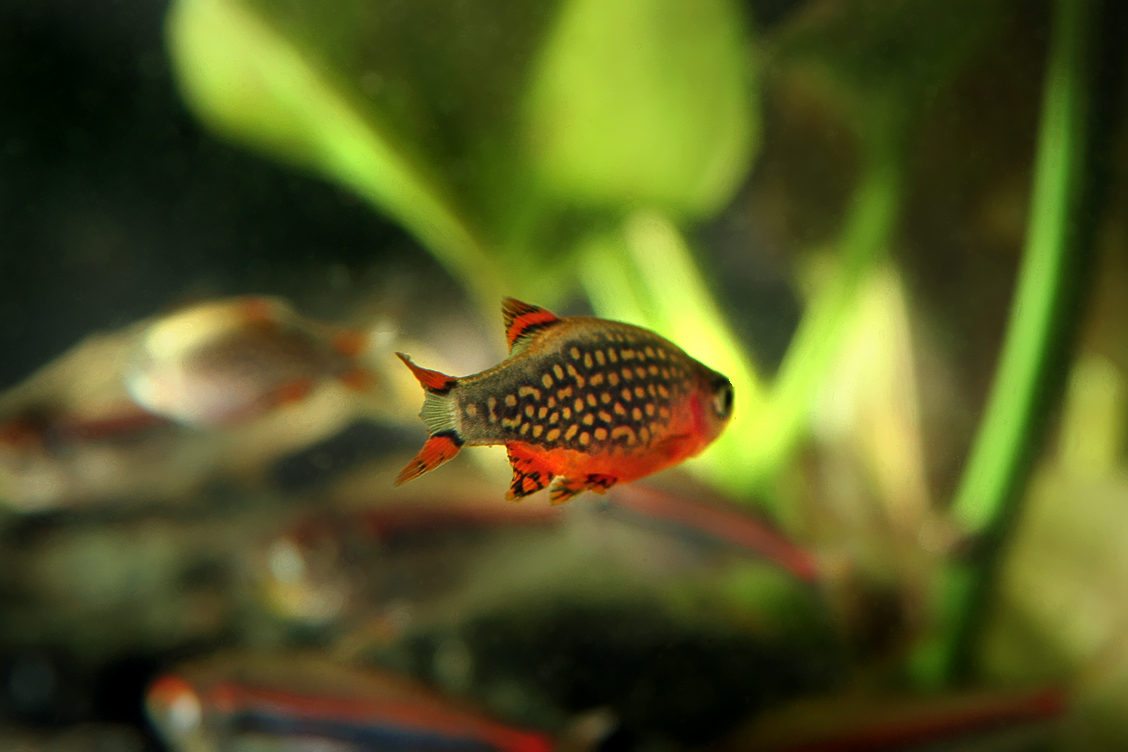The Least Killifish (Heterandria formosa) is a fascinating little fish native to North America. Despite its name, it is not a true killifish but belongs to the Poeciliidae family, which includes guppies and mollies. This fish is known for its small size, peaceful temperament, and ease of care, making it an excellent choice for both novice and experienced aquarists.
Table of Contents
The Least Killifish inhabits heavily vegetated, slow-moving freshwater and brackish waters in the southeastern United States, from North Carolina to Louisiana. It prefers environments with abundant aquatic vegetation and decaying organic matter, where it can find ample hiding spots and food sources. This species is a top and mid-dweller, often seen near the water’s surface in small groups.
One of the smallest fish species in North America, the Least Killifish measures between 2 and 4 cm in length. Males are typically smaller than females, with males reaching up to 2 cm and females up to 3 cm. The fish has an olive-colored body with a dark horizontal stripe and a dark spot on the dorsal fin. Females also have a dark spot on their anal fin.
The Least Killifish is omnivorous, feeding on a variety of aquatic invertebrates such as worms and crustaceans, as well as plant matter. In captivity, they can be fed a diet of flake food, brine shrimp, and other small live or frozen foods.
This species is viviparous, meaning it gives birth to live young. Males use a modified anal fin, called a gonopodium, to deliver sperm to the female. Unlike many livebearers, the Least Killifish releases its fry over an extended period, rather than all at once. This can result in up to 40 fry being born over a 10- to 14-day period. The average lifespan of the Least Killifish is about 1.5 years, though they can live up to 5 years under optimal conditions.
The scientific name Heterandria formosa derives from Greek and Latin roots. Heterandria combines “heteros” (other) and “andros” (male), referring to the different forms of males in the species. Formosa means “beautifully formed” in Latin, highlighting the fish’s delicate appearance.
Interesting Facts and Fun Facts
- The Least Killifish is one of the smallest vertebrates in North America.
- Despite its small size, it can be quite prolific, with females capable of producing multiple broods of fry.
- This fish is known for its fast-start escape response, a rapid burst of speed used to evade predators.
- It is a peaceful species but can be a fin-nipper in community tanks.
The Least Killifish is intriguing due to its small size and unique reproductive strategy. Its ability to thrive in both freshwater and brackish environments, along with its peaceful nature, makes it a versatile and low-maintenance addition to home aquariums. Additionally, its fascinating escape behaviors and social dynamics provide endless observation opportunities for aquarists.
Studies have shown that the Least Killifish exhibits significant inbreeding depression, affecting traits like reproductive performance and offspring viability. This highlights the importance of genetic diversity in maintaining healthy populations. Another study explored the fish’s fast-start escape response, revealing a complex three-dimensional kinematic repertoire that helps it evade predators.
Described by Girard in 1859, the Least Killifish has been a subject of interest for over a century. It is currently listed as “Least Concern” by the IUCN, indicating that it is not at immediate risk of extinction. However, habitat destruction and pollution could pose future threats to its populations.
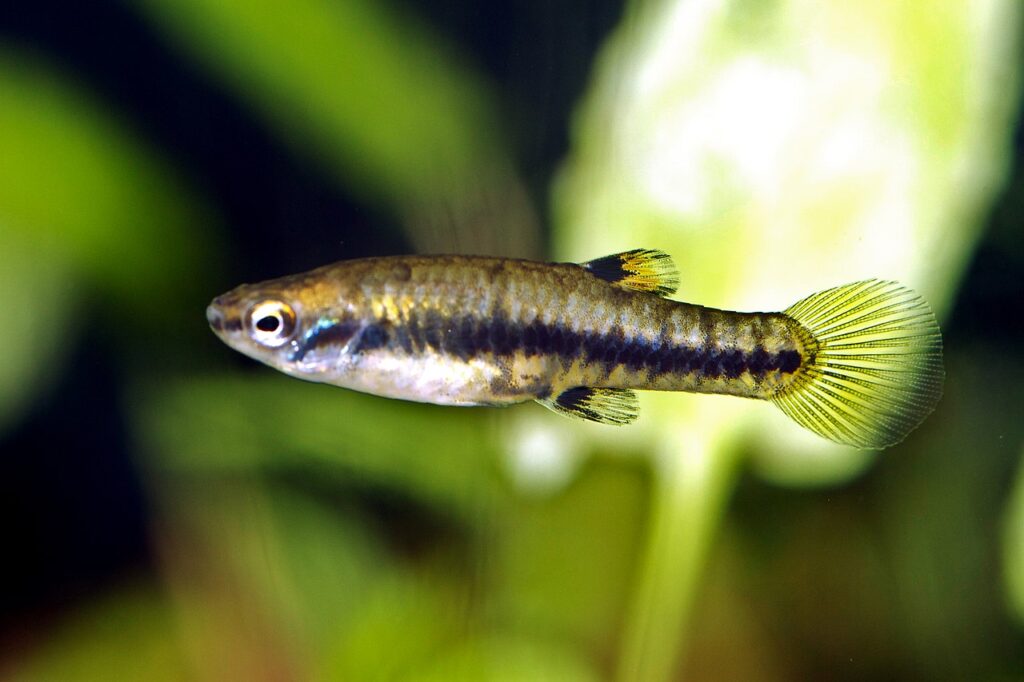
Least Killifish Key Information
The Least Killifish (Heterandria formosa) is a small yet captivating fish that exhibits an olive-colored body with a dark horizontal stripe running through the center. The males have a dark spot on their dorsal fin, while females also have a dark spot on their anal fin. This subtle but elegant coloration makes them a charming addition to any aquarium.
| Family | Poeciliidae |
| Origin | Southeastern United States |
| Price | Generally inexpensive, around $1-3 per fish |
| Common Names | Dwarf Topminnow, Mosquito Fish, Midget Livebearer |
| Variants | No significant color or morphological variants |
| Ideal Tank Size | 5-10 gallons |
| Water Parameters | Temperature: 68-78°F (20-26°C), pH: 6.5-8.0, Hardness: 5-20 GH |
| Lifespan | 1.5 to 5 years |
| Full Size | Males: up to 2 cm, Females: up to 3 cm |
| Natural Environment | Vegetated, slow-moving freshwater and brackish waters |
| Behavior | Peaceful, social, prefers groups |
| Habitat Preference | Top and mid-dweller |
| Aquarium Decoration | Heavily planted with floating plants and moss |
| Ideal Tank Mates | Pygmy Corydoras, small tetras, other small peaceful fish |
| Fish to Avoid | Large or aggressive fish, large crustaceans |
| Best Foods/Diet | Flake food, brine shrimp, small live or frozen foods |
| Disease | Generally hardy, but susceptible to common freshwater diseases |
| Sex-Switch | No known sex-switching behavior |
| Gender Differences | Males smaller with gonopodium, females larger with dark anal spot |
| Care Level | Easy |
| Breeding Level | Easy; superfetative livebearers, continuous release of fry over several days |
Ideal Tank Mates for Least Killifish
The Least Killifish (Heterandria formosa) is a peaceful and small fish, making it an excellent candidate for community tanks with other non-aggressive species. When selecting tank mates, it’s essential to choose fish that are similar in size and temperament to ensure a harmonious environment. Here are ten ideal tank mates for the Least Killifish, each with unique characteristics that make them compatible.
Neon Tetra
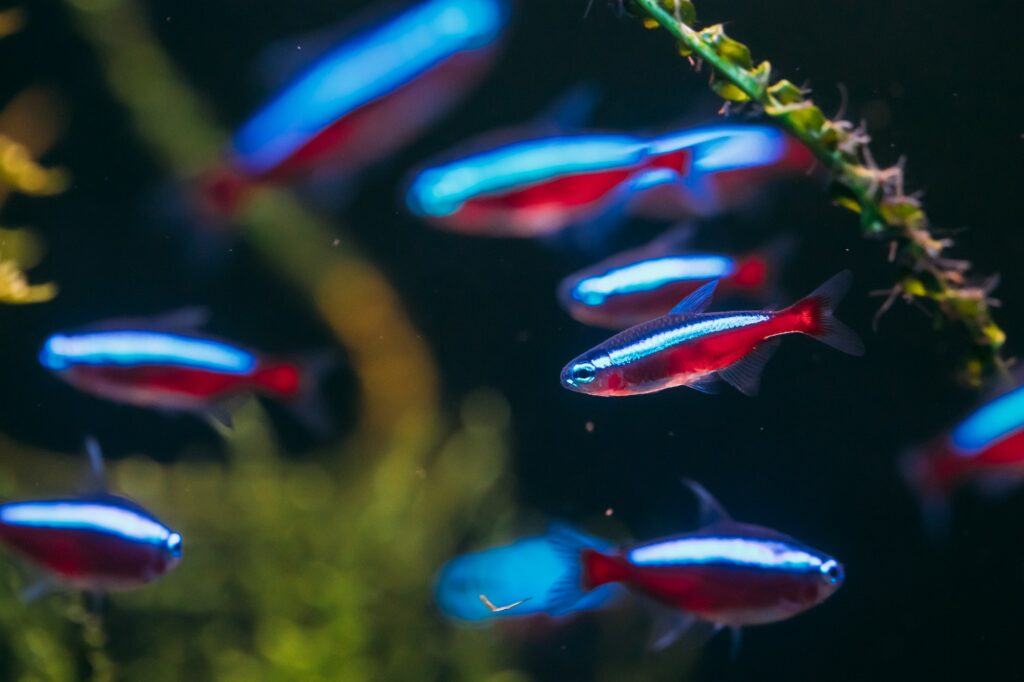
Neon Tetras are small, colorful fish that thrive in peaceful community tanks. Their vibrant blue and red stripes add a splash of color, complementing the subtle hues of the Least Killifish. Both species enjoy similar water conditions and are non-aggressive, making them perfect tank mates.
| Common/Market Names | Neon Tetra |
|---|---|
| Price Range | $1-$3 |
| Care Level | Easy |
| Behavior | Peaceful, schooling |
| Life Span | 5 years |
| Max Size | 1.5 inches (4 cm) |
Harlequin Rasbora

Harlequin Rasboras are known for their striking black and orange coloring. These fish are peaceful and prefer to swim in schools, creating a dynamic and visually appealing tank environment. Their calm nature and similar size make them ideal companions for the Least Killifish.
| Common/Market Names | Harlequin Rasbora |
|---|---|
| Price Range | $2-$4 |
| Care Level | Easy |
| Behavior | Peaceful, schooling |
| Life Span | 5-6 years |
| Max Size | 2 inches (5 cm) |
Pygmy Corydoras
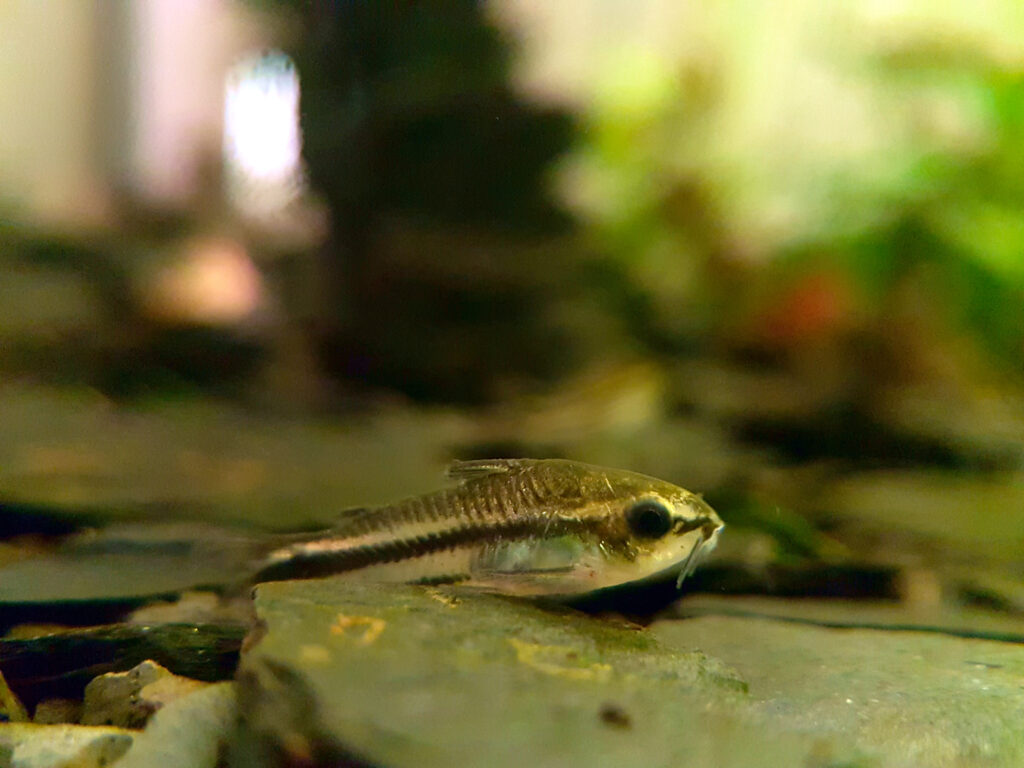
Pygmy Corydoras are small, bottom-dwelling catfish that add diversity to the tank’s ecosystem. Their peaceful nature and preference for the lower levels of the tank complement the Least Killifish, which typically inhabit the upper and middle levels. This separation reduces competition and promotes a balanced environment.
| Common/Market Names | Pygmy Corydoras |
|---|---|
| Price Range | $2-$5 |
| Care Level | Easy |
| Behavior | Peaceful, schooling |
| Life Span | 3-4 years |
| Max Size | 1 inch (2.5 cm) |
Cherry Shrimp
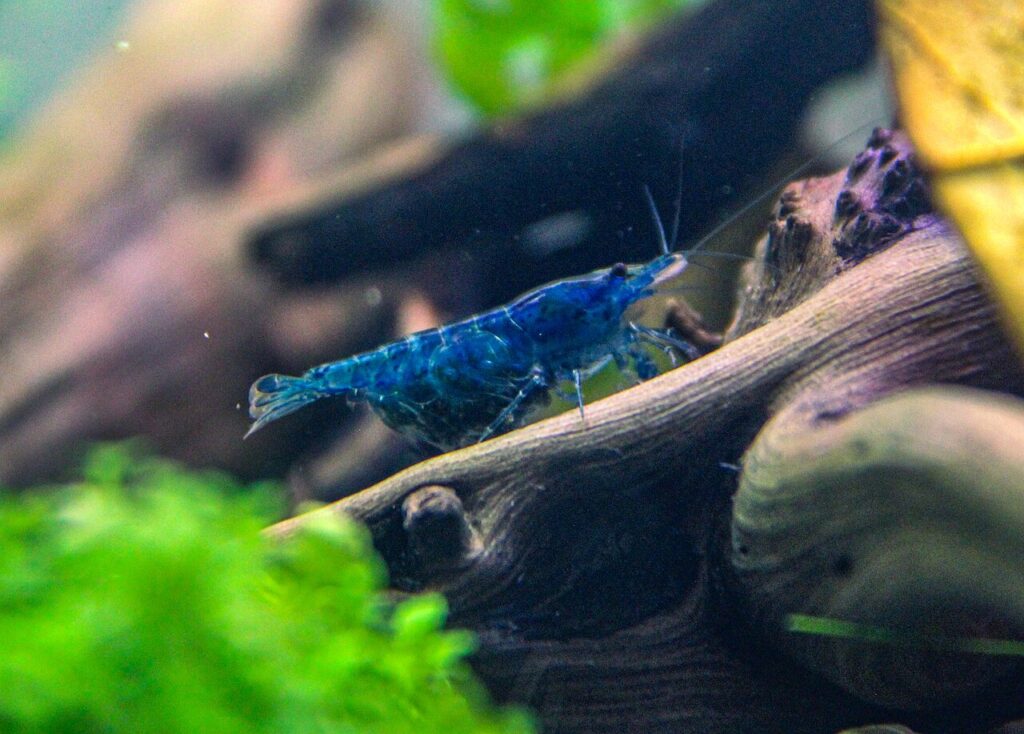
Cherry Shrimp are excellent tank mates due to their small size and peaceful nature. They help keep the tank clean by scavenging for leftover food and algae. Their bright red color adds a vibrant contrast to the tank, and they coexist well with Least Killifish, as they occupy different niches within the tank.
| Common/Market Names | Cherry Shrimp |
|---|---|
| Price Range | $1-$3 |
| Care Level | Easy |
| Behavior | Peaceful, scavenger |
| Life Span | 1-2 years |
| Max Size | 1.5 inches (4 cm) |
Ember Tetra
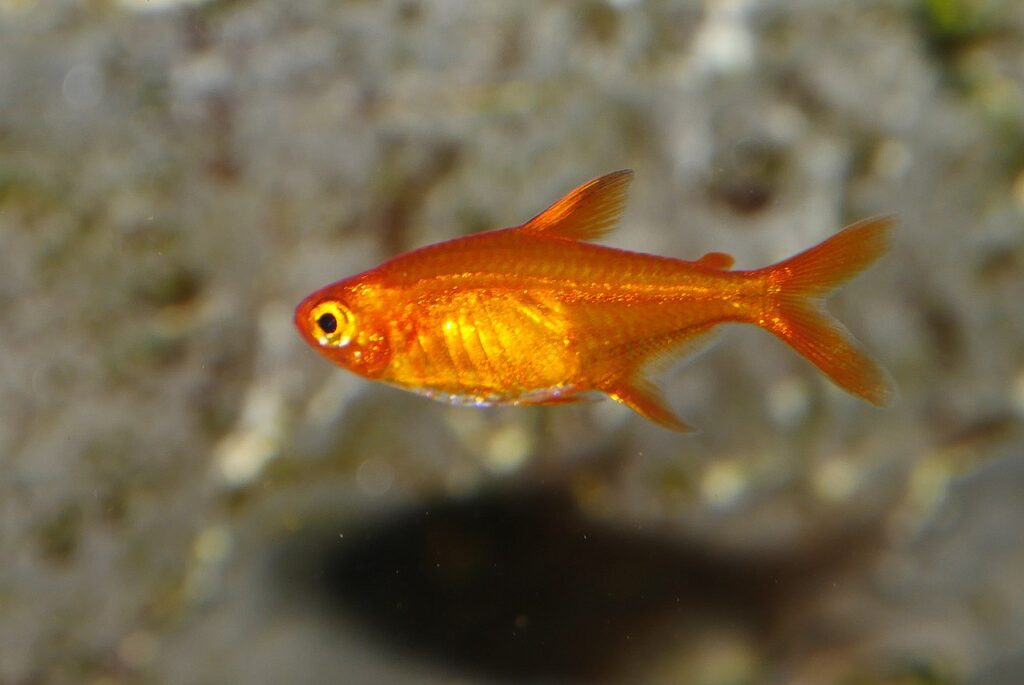
Ember Tetras are small, fiery-colored fish that bring warmth to the tank. Their peaceful demeanor and schooling behavior make them perfect companions for Least Killifish. Both species thrive in similar water conditions, ensuring a harmonious and visually appealing aquarium.
| Common/Market Names | Ember Tetra |
|---|---|
| Price Range | $2-$5 |
| Care Level | Easy |
| Behavior | Peaceful, schooling |
| Life Span | 2-4 years |
| Max Size | 1 inch (2.5 cm) |
Endler’s Livebearer
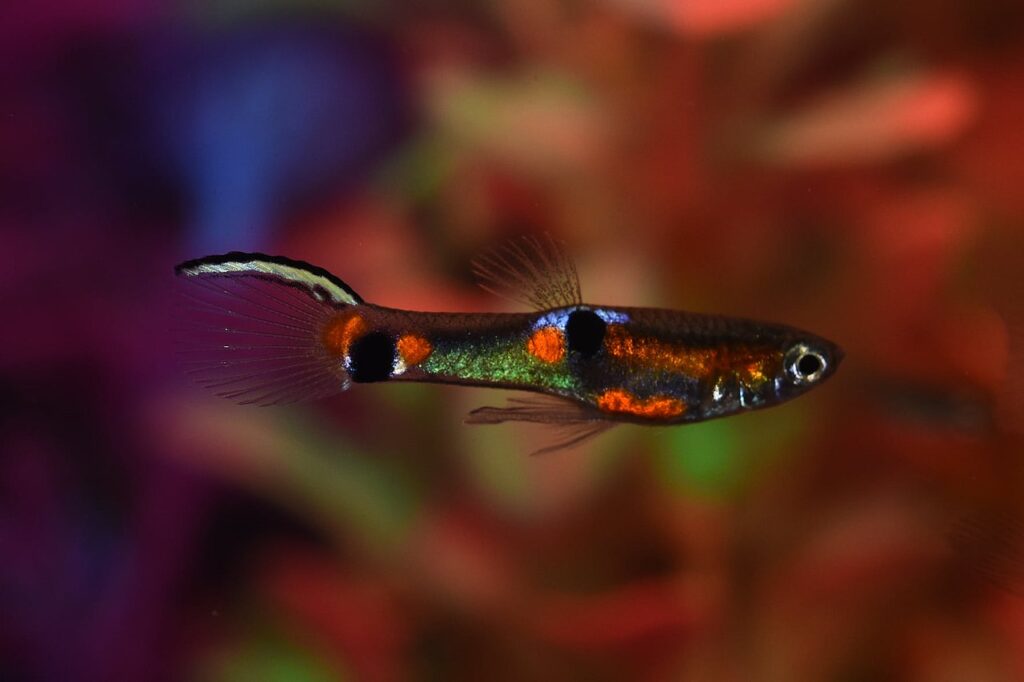
Endler’s Livebearers are small, colorful fish that are closely related to guppies. Their vibrant patterns and peaceful nature make them excellent tank mates for Least Killifish. Both species are livebearers, which can add an interesting dynamic to the tank as they reproduce.
| Common/Market Names | Endler’s Livebearer |
|---|---|
| Price Range | $2-$5 |
| Care Level | Easy |
| Behavior | Peaceful, active |
| Life Span | 2-3 years |
| Max Size | 1.8 inches (4.5 cm) |
Otocinclus Catfish
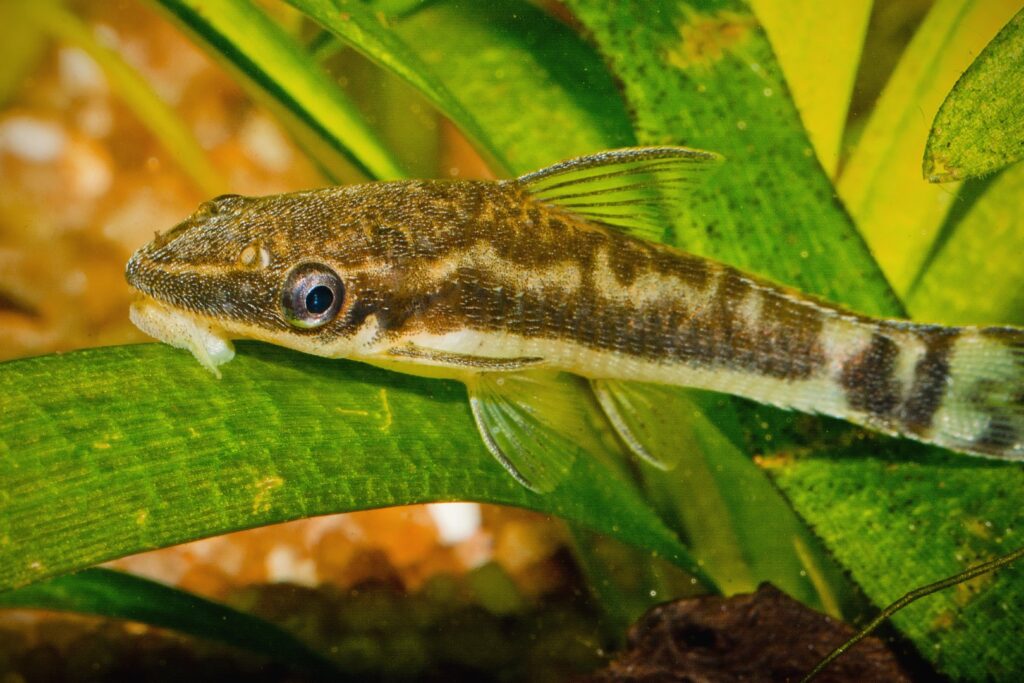
Otocinclus Catfish, also known as Oto Cats, are small algae-eating fish that help maintain a clean tank environment. Their peaceful nature and preference for the bottom of the tank make them compatible with Least Killifish. They are also non-aggressive and enjoy similar water parameters.
| Common/Market Names | Otocinclus Catfish |
|---|---|
| Price Range | $2-$4 |
| Care Level | Moderate |
| Behavior | Peaceful, schooling |
| Life Span | 3-5 years |
| Max Size | 2 inches (5 cm) |
Dwarf Gourami
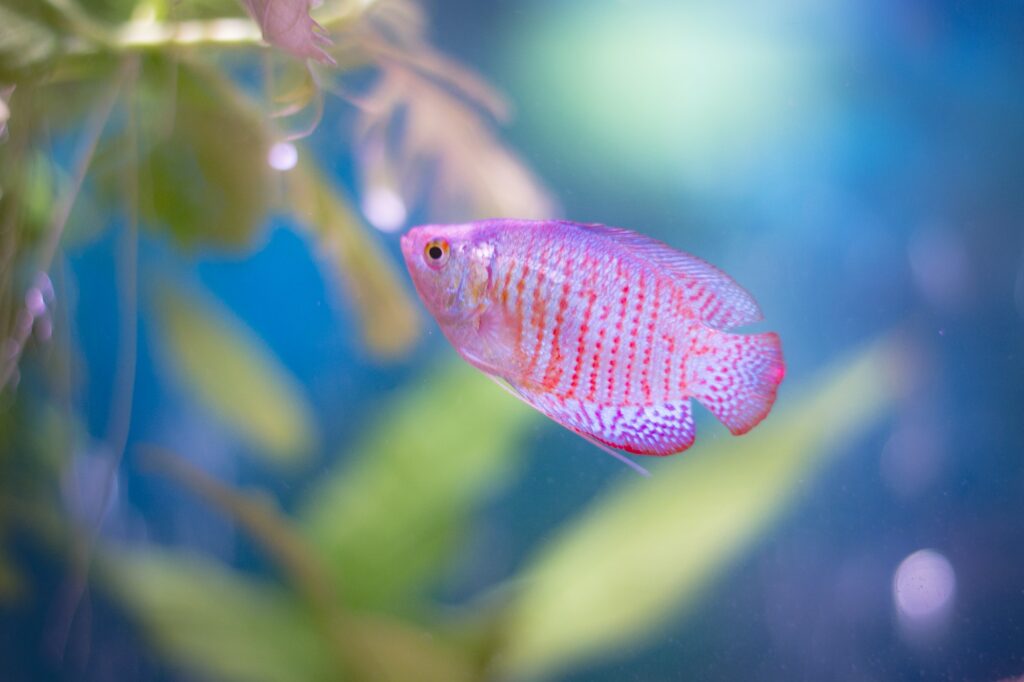
Dwarf Gouramis are small, colorful fish that add a touch of elegance to the tank. Their peaceful nature and slow swimming habits make them suitable companions for Least Killifish. They prefer well-planted tanks, which aligns with the habitat preferences of Least Killifish.
| Common/Market Names | Dwarf Gourami |
|---|---|
| Price Range | $4-$8 |
| Care Level | Moderate |
| Behavior | Peaceful, territorial |
| Life Span | 4-6 years |
| Max Size | 3.5 inches (9 cm) |
Celestial Pearl Danio
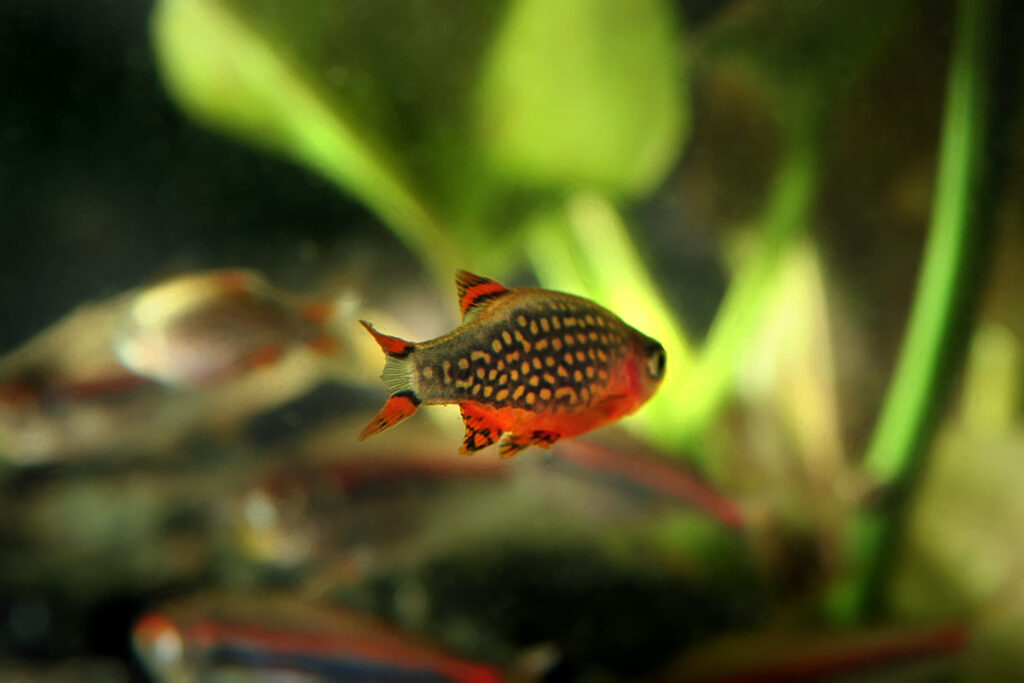
Celestial Pearl Danios, also known as Galaxy Rasboras, are small, colorful fish with a peaceful temperament. Their striking appearance and schooling behavior make them excellent tank mates for Least Killifish. They thrive in similar water conditions and enjoy densely planted tanks.
| Common/Market Names | Celestial Pearl Danio |
|---|---|
| Price Range | $3-$6 |
| Care Level | Moderate |
| Behavior | Peaceful, schooling |
| Life Span | 3-5 years |
| Max Size | 1 inch (2.5 cm) |
White Cloud Mountain Minnow
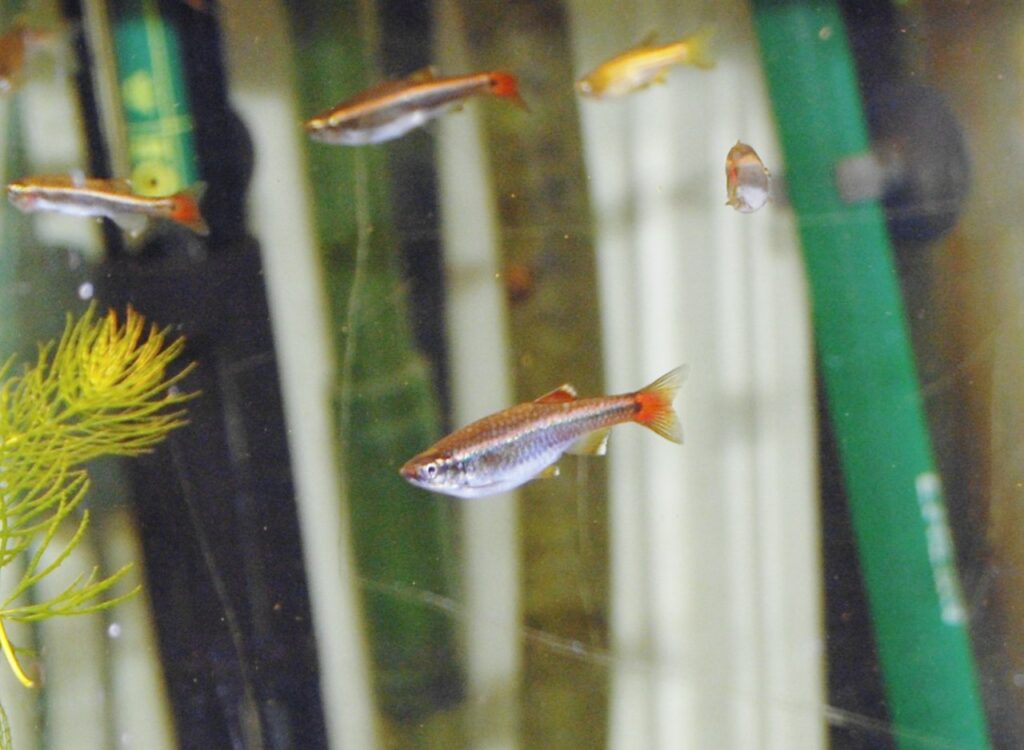
White Cloud Mountain Minnows are hardy, peaceful fish that thrive in cooler water conditions. Their adaptability and non-aggressive nature make them compatible with Least Killifish. They prefer to swim in schools, creating a lively and dynamic tank environment.
| Common/Market Names | White Cloud Mountain Minnow |
|---|---|
| Price Range | $1-$3 |
| Care Level | Easy |
| Behavior | Peaceful, schooling |
| Life Span | 5-7 years |
| Max Size | 1.5 inches (4 cm) |
By carefully selecting these compatible tank mates, you can create a vibrant and harmonious community tank that showcases the unique beauty and peaceful nature of the Least Killifish.
FAQs about Least Killifish
How can I tell the difference between male and female Least Killifish?
Male and female Least Killifish can be distinguished by size and specific markings. Males are smaller, reaching up to 0.8 inches (2 cm), and have a gonopodium, a modified anal fin used for reproduction. Females are larger, up to 1.2 inches (3 cm), and have a black spot on their anal fin.
What type of lighting is best for a Least Killifish tank?
Least Killifish do not have specific lighting requirements, but moderate lighting is ideal to support plant growth. Using LED lights that can simulate a natural day-night cycle will help maintain the fish’s diurnal activity patterns.
Are Least Killifish good for beginners?
Yes, Least Killifish are excellent for beginners due to their hardiness and ease of care. They can tolerate a range of water conditions and are not picky eaters, making them a low-maintenance choice for novice aquarists.
What is the best way to feed Least Killifish?
Least Killifish should be fed small amounts of food that they can consume within five minutes. They enjoy a varied diet of high-quality flake food, micro-pellets, and live or frozen foods like daphnia and brine shrimp.
How often should I perform water changes in a Least Killifish tank?
Regular water changes are crucial for maintaining water quality. A biweekly 40% water change is recommended. Be cautious when performing water changes to avoid siphoning up tiny fry, as they are very small and can be easily overlooked.
Can Least Killifish be kept in a pond?
Yes, Least Killifish can be kept in outdoor ponds, particularly in warmer climates. They thrive in shallow, planted areas at the water’s edge, which mimic their natural habitat. Ensure the pond has adequate cover and is protected from predators.
What are some common health issues for Least Killifish?
Least Killifish are generally hardy but can be susceptible to common freshwater diseases such as fin rot and ich. Maintaining good water quality and a stable environment can help prevent these issues.
Do Least Killifish need a heater in their tank?
Least Killifish can tolerate a wide range of temperatures, but if the room temperature fluctuates significantly, an in-line heater may be necessary to maintain a stable environment, especially during colder months.
How do I create an ideal habitat for Least Killifish?
An ideal habitat for Least Killifish includes a well-planted tank with plenty of hiding spots and low water flow. Use a sponge pre-filter to prevent the tiny fish from being sucked into the filter. A substrate of fine sand or small gravel will mimic their natural environment.
Are Least Killifish compatible with shrimp?
While Least Killifish can coexist with shrimp, they may prey on shrimp fry and molting shrimp. If you decide to keep them together, provide plenty of hiding spots and dense plant cover to protect the shrimp.

